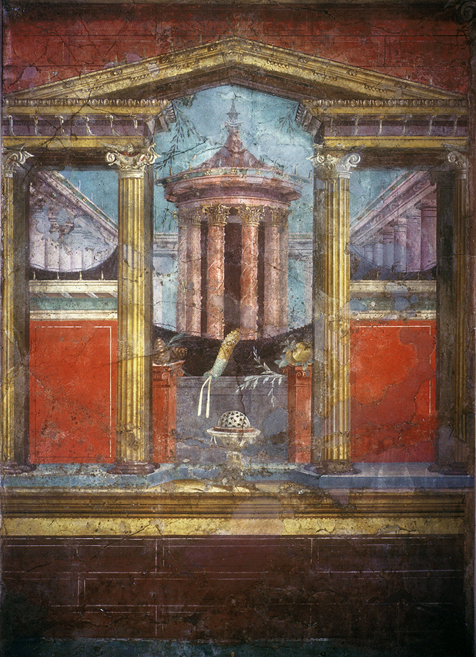 1
1As if taken aback by his proposition that door imagery in Roman wall-painting was derived from tomb architecture, Picard goes on to say, “This obvious conclusion, however, has been universally set aside until now, because no one was willing to admit that a Roman could have thought of having a tomb painted on his bedroom wall, a motif hardly conducive to pleasant thoughts; on the contrary, one likely to give terrible nightmares to whoever believed in ghosts, which was almost everyone.” (Picard 1970:97) The fact that the Boscoreale door image is generally thought to have existed in a triclinium (dinning area) and not a bedroom, does not undermine the significance of Picard’s proposition, because ritual banqueting as a matter of course included references to deceased family members. Hence a door to the underworld would have been entirely appropriate. Depictions of sanctuary gardens and tomb-like facades were also found in rooms elsewhere in the same villa (fig.1).
Picard supported his proposition that the false-door represented an in-house tomb facade by quoting the French Roman Historian Albert Grenier, “However, this apparently absurd idea becomes much less so if we remind ourselves of several well-known aspects of the Roman religion. “The tomb,” writes A. Grenier (Religion Romaine p87) “is originally the common property of the family. The soul of the ancestors is supposed to survive, but on certain fixed days it haunts the home of the living. The Manes (shades of the dead) more or less mingle with the other gods of the house, the Lares and Penates. The very spirit of the father is their emanation; he is represented by the serpent which emerges from the earth in order to come to taste the offerings of the family hearth.” Thus it is not extraordinary that the Door of the Shades, which they pass through especially on the night of the Lemuralia, is in the chamber of the head of the family.” Picard then summarises the above within the context of the House as Sanctuary, “The origin of the theme of crossing over the wall is found, therefore in our view, in the old Italian beliefs, which were very much alive in Pompeii, as the existence of a lararium and a family altar in each house proves. The substitution of the tholos for the door is easily explicable within this perspective: the most common intention of the circular colonnaded pavilion is a funerary effect. It depicts the tomb of the heroized ancestor-protector of the family.” (Picard 1970: 97)
Picard’s observation that certain wall-paintings represented tomb facades and that these and other objects symbiotically gave the house a sanctuary-like appearance, is both astonishing and challenging. Especially since virtually every other writer on the subject has avoided the problem of signification. There is even the possibility that Picard himself eventually found it too radical, since he did not expanded upon it. However, if correct, and the entrance motifs are indexically and symbolically linked to metaphysical worlds, than we need to analyse how it achieved this and, more importantly, why? [Gilles Sauron's publications: La Peinture Allégorique À Pompéi - Le Regard De Cicéron, 2007; and Les Décors Privés Des Romains, 2009, are amongst the very few excellent examples of iconological studies that locate Roman wall-painting in its contemporary political, philosophical, mythological and allegorical context].
|